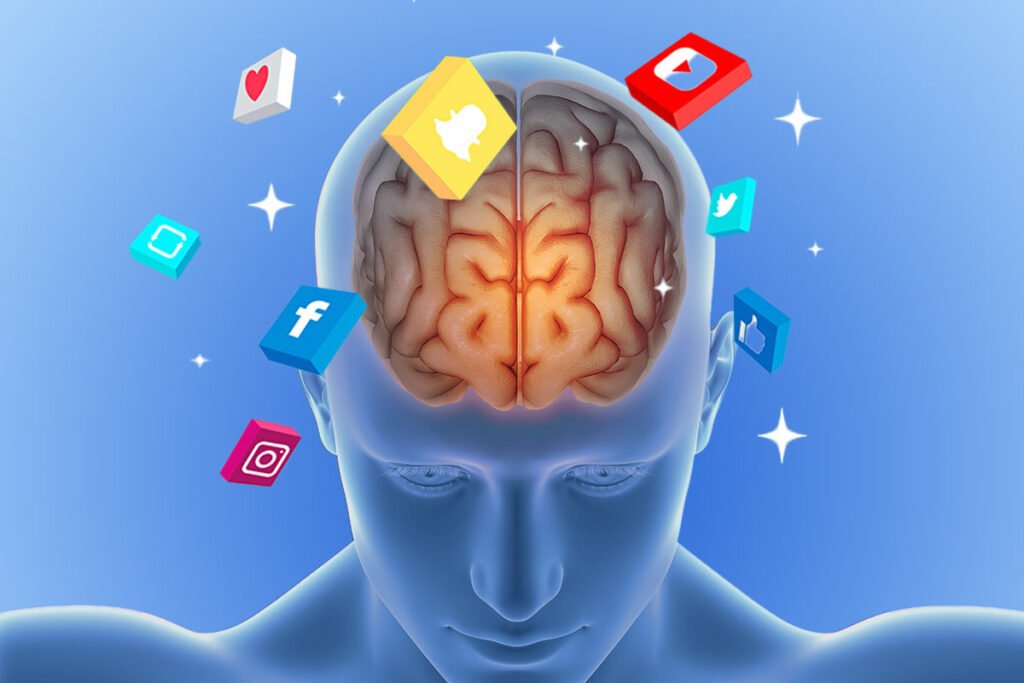Why in the News?
- Dopamine is the brain’s key “reward” chemical which explains why modern stimuli (drugs, social media, games) feel compelling and can lead to addiction.
- Rising concerns about screen time, attention problems and youth mental health make understanding dopamine important for public policy and personal well-being.
Key Highlights
- What is dopamine?
- Dopamine is a brain chemical (neurotransmitter) that signals reward, motivation and learning. When we enjoy something like food, praise, achievement, then the dopamine release makes us want to repeat it.
- How does the brain’s reward circuit work?
- The mesolimbic pathway is a connection in the brain that controls how we feel pleasure and motivation. It links two main parts — the ventral tegmental area (VTA), which releases the “feel-good” chemical dopamine, and the nucleus accumbens, which receives it.
- When we do something enjoyable, like eating or achieving a goal, this pathway gets activated. It helps our brain remember what made us feel good so that we try to do it again. This system is what drives motivation, reward, and learning from positive experiences.
- Dopamine: From substances to screens
- Earlier, addiction was mainly caused by substances such as drugs, alcohol, or nicotine. These triggered huge releases of dopamine, making people feel intense pleasure. Over time, the brain became desensitised, needing more of the substance to feel normal, which led to addiction.
- Today, the same kind of addiction is seen with technology and screens. Every time we get a message, “like,” or watch a short video, our brain releases a small amount of dopamine, which makes us feel good. Apps and social media are made to keep us hooked, just like slot machines that give random rewards, making us check our phones again and again.
- Effects on attention and youth mental health
- This constant stimulation rewires the brain’s reward system, especially in young people. It can lead to short attention spans, anxiety, restlessness, and reduced ability to enjoy real-life experiences.
- In short, the addiction to substances has evolved into an addiction to screens, both exploiting the same dopamine-driven pleasure pathways in the brain.
- What dopamine overload does to everyday life?
- Constant overstimulation can reduce enjoyment of ordinary activities, cause fatigue of the reward system, lower motivation for long-term goals, disturb sleep, and worsen mental health.
- How to rebalance dopamine?
- Balance is the goal — not elimination. Measures include digital detoxes (tech breaks, greyscale screens), mindfulness, physical activity, good sleep and meaningful social interaction. These promote steady, sustainable reward and restore motivation for deeper activities.
Key TermDopamine Fasting (Practical Tool) 1. A temporary, intentional reduction of high-stimulus activities (social media, junk food, nonstop entertainment) to reduce compulsive seeking. 2. Aims to restore sensitivity to natural rewards, such as exercise, learning, relationships. 3. Should be practiced sensibly, not as permanent deprivation and combined with sleep, nutrition and social support. 4. Useful as a self-management strategy. |
Implications
- Public health challenge: Widespread screen-related dopamine overstimulation may increase anxiety, depression and attention disorders, particularly among young people.
- Education impact: Shorter attention spans can affect learning outcomes and require changes in teaching methods and curriculum design.
- Workplace productivity: Constant digital distractions reduce deep-work capacity and can lower long-term productivity despite short bursts of engagement.
- Consumer & platform responsibility: Tech firms’ dopamine-optimised designs raise ethical questions about addiction, especially for minors.
- Policy need: Regulators may need to consider digital-wellness guidelines, age limits, and awareness campaigns to protect vulnerable groups.
Challenges and Way Forward
| Challenge | Way Forward |
| Pervasive attention-stealing design (notifications, autoplay) | Promote design ethics, offer default “do not disturb” modes, and encourage platforms to provide time-use reports. |
| Youth vulnerability | Introduce digital-literacy and mental-health education in schools; set age-appropriate limits and parental controls. |
| Stigma around behavioural addiction | Run public campaigns to normalise help-seeking; increase access to counselling and digital-detox programs. |
| Workplace distraction culture | Encourage organisational policies for focused work (no-meeting blocks, device-free times) and promote mindfulness breaks. |
| Measuring harm & policy evidence gap | Fund longitudinal research on screen time, dopamine changes, and mental health to guide evidence-based regulation. |
Conclusion
Dopamine is essential for motivation and learning, but modern life’s steady stream of quick rewards can unbalance the brain’s reward system. Reclaiming balance through reduced tech overuse, exercise, sleep, social connection and mindful living restores sustainable pleasure and mental resilience without rejecting the benefits of technology.
| EnsureIAS Mains Question Q. Explain how dopamine mediates reward and addiction. Discuss the impact of modern digital platforms on dopamine-driven behaviour and suggest policy and individual-level measures to prevent harm. (250 Words) |
| EnsureIAS Prelims Question Q. With reference to dopamine and behaviour, consider the following statements: 1. Dopamine release in the mesolimbic pathway only signals pleasure, not motivation or learning. 2. Repeated overstimulation of dopamine systems can lead to desensitisation, requiring stronger stimuli to achieve the same effect. 3. Social media and short-video platforms can activate the same reward circuits involved in substance addiction. 4. “Dopamine fasting” means permanently stopping all rewarding activities to eliminate dopamine. Which of the statements given above are correct? Answer: A. 2 and 3 only Explanation: Statement 1 is Incorrect: Dopamine does not only signal pleasure. It plays a broader role in motivation, reward prediction and learning, helping organisms pursue goals. Reducing dopamine to “pleasure only” is an oversimplification. Statement 2 is Correct: Repeated large or frequent stimulation causes neuroadaptation (desensitisation): receptors down-regulate and stronger stimuli are needed to trigger the same reward response; a core mechanism in addiction. Statement 3 is Correct: Functional brain studies show that social media engagement and short-video viewing can activate the nucleus accumbens and related reward circuits; the same brain network engaged by addictive substances. Statement 4 is Incorrect: Dopamine fasting is usually a temporary practice to reduce overstimulation and reset reward sensitivity, not permanent elimination of all rewarding activities; which would be neither possible nor healthy. |
Also Read | |
| UPSC Foundation Course | UPSC Daily Current Affairs |
| UPSC Monthly Magazine | CSAT Foundation Course |
| Free MCQs for UPSC Prelims | UPSC Test Series |
| Best IAS Coaching in Delhi | Our Booklist |





